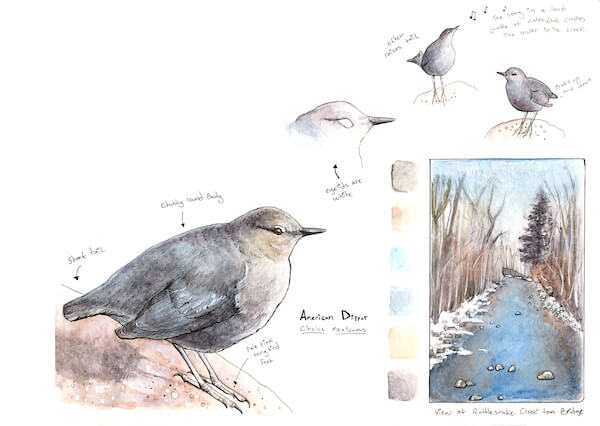How North America’s Only Aquatic Songbird Survives Spring Runoff
by Elizabeth Domenech
Broadcast 4.27 & 4.30.2021

American Dipper illustrations by Jenah Mead.
Listen:
The American Dipper is one of my favorite birds. I love the movement they make standing in shallow water or on a rock, the bend in the ankle and rhythm of their bouncing reminiscent of a dance. Mostly, though, I love that they are one of the only birds that stays in southwestern Montana through the winter. I have seen them bobbing for food on the coldest of days in a nearly frozen river or stream, their mere presence heartening in an otherwise seemingly vacant landscape.
And yet the American Dippers I have observed are typically either on a rock, a log, or in shallow water along the bank of the river, which begs the question – what do the dippers do in runoff season, when rivers and streams roar, rocks lie buried beneath the rushing water, and streams reach bankfull?
The American Dipper, Cinclus mexicanus, is also known as a water ouzel. It is the only aquatic songbird found in North America. Unlike other songbirds, but like ducks, adult American Dippers undergo complete molting, where they lose all of their flight feathers at one time during the year. This process renders the dipper flightless for a period of five to fourteen days. While we would not expect to observe the dipper during this time period, molting for dippers typically occurs in August, after the main runoff has occurred, and thus does not provide an answer to the question ‘what do dippers do during spring runoff?’
Dippers breed earlier in the spring than many other songbirds, an adaptation to their riverine habitat. It appears American Dippers pair off and begin courtship prior to runoff for several reasons. The egg formation process for females is energetically expensive, and runoff decreases food availability, so it is advantageous to mate and lay eggs while food is still plentiful. Additionally, the dippers’ food sources can run out later in the summer as temperatures increase and streams run dry. American Dippers’ diet consists largely of aquatic invertebrates and their larvae such as mayflies, mosquitos, and midges. They will also eat fish eggs, flying insects, worms, dragonflies, and small fish.
American Dippers nest from April to July, overlapping with runoff season. In response, dippers build their nest sites six to twenty feet above deep water to avoid having their nests washed away by floods. Flooding is a leading cause of American Dipper mortality, limiting population numbers based on the availability of suitable nesting locations. While incubating her eggs, the female dipper remains on the nest for a period of two weeks, spending nearly four times as long on the nest incubating as feeding. Naturally, we would expect to encounter the female dippers less during this incubation period.
Once they are born, American Dipper nestlings remain dependent on their parents for food for nearly a month. Both male and female adults feed the nestlings, relying on specialized foraging strategies that include a combination of wading and swimming: ‘flycatching’ by flying low over the water and snatching insects on the wing; diving all the way under water; and even walking on the bottom of riverbeds to feed. During spring runoff season, this diversity of feeding techniques lends the dipper an advantage. When high water levels make it hard for the dipper to forage along the bank edge, or rushing water makes walking under water nearly impossible, dippers are still able to rely on their diving and flycatching skills to bring food back to their nestlings.
With the arrival of the next runoff, my spirits will be buoyed by the knowledge that one of my favorite birds is uniquely adapted to survive the high water and that I must only be patient before I see their water dance resume once more.
Every week since 1991, Field Notes has inquired about Montana’s natural history. Field Notes are written by naturalists, students, and listeners about the puzzle-tree bark, eagle talons, woolly aphids, and giant puffballs of Western, Central and Southwestern Montana and aired weekly on Montana Public Radio.
Click here to read and listen to more Field Notes. Field Notes is available as a podcast! Subscribe on iTunes, Google Play, or wherever you listen to podcasts.
Interested in writing a Field Note? Contact Allison De Jong, Field Notes editor, at adejong [at] montananaturalist [dot] org or 406.327.0405.
Want to learn more about our programs as well as fun natural history facts and seasonal phenology? Sign up for our e-newsletter! You can also become a member and get discounts on our programs as well as free reciprocal admission to 300+ science centers in North America!












